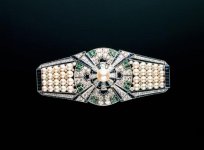kiwipaul
Community member
- Joined
- May 21, 2013
- Messages
- 195
I'm a pretty determined jewelry collector via on-line and antique fairs and markets, and over the year I've bought a few bargain priced Mikimoto pieces when I find them.
Most are 1940's (post war occupation forces) to 1970's pieces (bought by tourists on trips to Singapore and Hong Kong), later disposed of by unsympathetic family who don't want grandma's pearls. Most are silver stamped "SIL" or "S" with the Mikimoto "Pearl in a Clamshell" logo.
Often these require minor repairs, when broken clasps or pins on brooches need straightening out or re-attaching.
I use a very good manufacturing jeweler with laser welder and bench trained artisans, and he despairs when I bring these pieces in.
According to him it is very difficult to refinish Mikimoto silver items once repaired, because whatever Mikimoto used to (electro) plate their silver items is difficult to match.
He says it's much harder and thicker than normal rhodium plating, he says almost like a chromium plate.
Does anyone actually know what the final surface plating material was that Mikimoto used 'back in the day' to finish their silver jewelry?
Thanks and best regards
Kiwipaul
Most are 1940's (post war occupation forces) to 1970's pieces (bought by tourists on trips to Singapore and Hong Kong), later disposed of by unsympathetic family who don't want grandma's pearls. Most are silver stamped "SIL" or "S" with the Mikimoto "Pearl in a Clamshell" logo.
Often these require minor repairs, when broken clasps or pins on brooches need straightening out or re-attaching.
I use a very good manufacturing jeweler with laser welder and bench trained artisans, and he despairs when I bring these pieces in.
According to him it is very difficult to refinish Mikimoto silver items once repaired, because whatever Mikimoto used to (electro) plate their silver items is difficult to match.
He says it's much harder and thicker than normal rhodium plating, he says almost like a chromium plate.
Does anyone actually know what the final surface plating material was that Mikimoto used 'back in the day' to finish their silver jewelry?
Thanks and best regards
Kiwipaul
Last edited:

